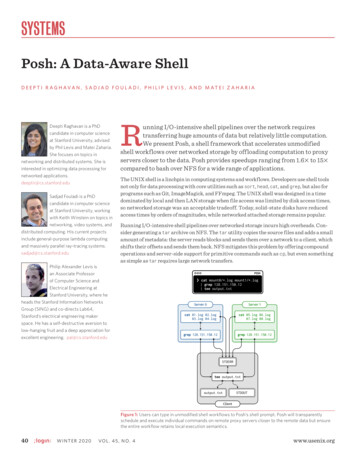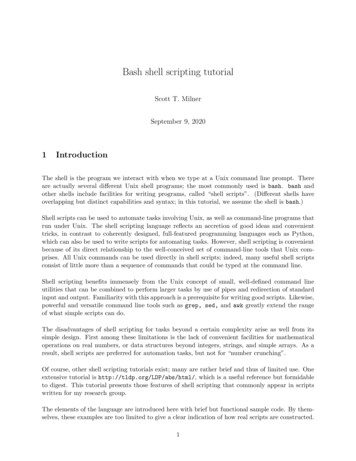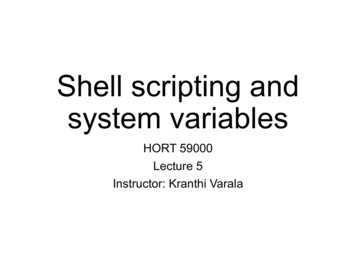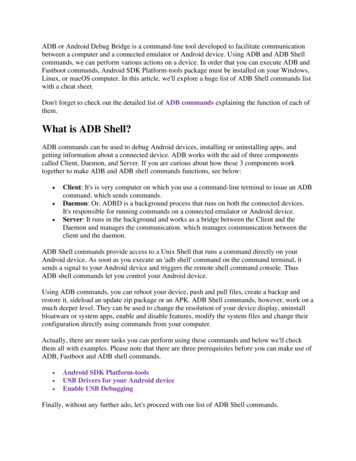
Transcription
SYSTEMSPosh: A Data-Aware ShellD E E P T I R A G H AVA N , S A D J A D F O U L A D I , P H I L I P L E V I S , A N D M AT E I Z A H A R I ADeepti Raghavan is a PhDcandidate in computer scienceat Stanford University, advisedby Phil Levis and Matei Zaharia.She focuses on topics innetworking and distributed systems. She isinterested in optimizing data processing fornetworked applications.deeptir@cs.stanford.eduSadjad Fouladi is a PhDcandidate in computer scienceat Stanford University, workingwith Keith Winstein on topics innetworking, video systems, anddistributed computing. His current projectsinclude general-purpose lambda computingand massively parallel ray-tracing systems.sadjad@cs.stanford.eduPhilip Alexander Levis isan Associate Professorof Computer Science andElectrical Engineering atStanford University, where heheads the Stanford Information NetworksGroup (SING) and co-directs Lab64,Stanford’s electrical engineering makerspace. He has a self-destructive aversion tolow-hanging fruit and a deep appreciation forexcellent engineering. pal@cs.stanford.eduRunning I/O-intensive shell pipelines over the network requirestransferring huge amounts of data but relatively little computation.We present Posh, a shell framework that accelerates unmodifiedshell workflows over networked storage by offloading computation to proxyservers closer to the data. Posh provides speedups ranging from 1.6 to 15 compared to bash over NFS for a wide range of applications.The UNIX shell is a linchpin in computing systems and workflows. Developers use shell toolsnot only for data processing with core utilities such as sort, head, cat, and grep, but also forprograms such as Git, ImageMagick, and FFmpeg. The UNIX shell was designed in a timedominated by local and then LAN storage when file access was limited by disk access times,so networked storage was an acceptable tradeoff. Today, solid-state disks have reducedaccess times by orders of magnitudes, while networked attached storage remains popular.Running I/O-intensive shell pipelines over networked storage incurs high overheads. Consider generating a tar archive on NFS. The tar utility copies the source files and adds a smallamount of metadata: the server reads blocks and sends them over a network to a client, whichshifts their offsets and sends them back. NFS mitigates this problem by offering compoundoperations and server-side support for primitive commands such as cp, but even somethingas simple as tar requires large network transfers.Figure 1: Users can type in unmodified shell workflows to Posh’s shell prompt. Posh will transparentlyschedule and execute individual commands on remote proxy servers closer to the remote data but ensurethe entire workflow retains local execution semantics.40W I N T E R 2 02 0VO L . 4 5 , N O . 4www.usenix.org
SYSTEMSPosh: A Data-Aware ShellMatei Zaharia is an AssistantProfessor of ComputerScience at Stanford and ChiefTechnologist at Databricks.He started the Apache Sparkproject during his PhD at UC Berkeley and hasworked on other widely used data analyticsand AI software, including MLflow and DeltaLake. At Stanford, he is co-PI of the DAWNlab working on infrastructure for machinelearning. Matei’s research was recognizedthrough the 2014 ACM Doctoral DissertationAward, an NSF CAREER Award, and the USPECASE award. matei@cs.stanford.eduFigures 2 and 3: End-to-end latency of Posh on two applications, compared to NFS sync, NFS async, andlocal execution time for two networks, one where the client is in a university network and one where theclient is in the same GCP region as the storage server. The Posh proxy runs directly on the NFS server. Poshprovides between 1.6–12.7 speedups in the university-to-cloud network compared to NFS.The underlying performance problem of using the shell with remote data is locality: becausethe shell executes locally, it must move large amounts of data to and from remote servers.Data movement is usually the most expensive (time and energy) part of a computation, andshell workloads are no exception. Near-data processing [1] is not a new paradigm: systemssuch as Spark [2], Active-Disks [3], and stored procedures in databases all move computationcloser to the data. However, these systems require applications to use their APIs: they cansupplement but not replace shell pipelines.To address the shell performance problem of data locality, this article presents Posh, the“Process Offload Shell,” a system that offloads portions of unmodified shell workflows toproxy servers closer to the data. A proxy server can run on the actual remote file serverstoring the data, or on a different node that is much closer to the data (e.g., within the samedatacenter) than the client. Posh identifies parts of shell pipelines that can be safely offloadedto a proxy server and selects which candidates run on a proxy in order to minimize data movement. It then distributes computation across an underlying runtime while maintaining theexact output semantics expected by a local program. Figure 1 shows running a workflow viaPosh. The user enters the unmodified workflow at the shell prompt and the output appears atthe client’s shell as normal, but Posh offloads some of the commands.Posh is available at https://github.com/deeptir18/posh. This article will cover examples ofshell workflows where Posh can be useful, a brief overview of the core ideas behind Posh, andhow to get started with the system. For a detailed discussion of the research ideas behindPosh, we refer the reader to our USENIX ATC ’20 paper [4].Examples of PoshPosh is useful for shell workflows that are I/O bound, have smaller output than input size, aremetadata heavy (make many file-system stat() requests), or are parallelizable. In this section, we will discuss examples of shell workflows that incur large overheads over networkedstorage and show that Posh accelerates them to achieve near-local execution time. Figures2–4 illustrate the execution time of running each of these applications with an NFS mountconfigured with either sync and async, and with Posh, over two network settings: one wherethe client is in the same GCP region as the storage server (“cloud”) and one where the client isin a university network outside the datacenter (“university”). Posh can offload computationwww.usenix.orgW I N T E R 2 02 0VO L . 4 5 , N O . 441
SYSTEMSPosh: A Data-Aware ShellFigure 4: Average latency of 20 git status, git add, and git commit commands run on Chromium repo, of Posh compared to NFS and local execution,for a client in the same cloud datacenter as the storage server. Posh provides up to 10–15 speedups by preventing round trips for file system metadata calls.to a proxy server directly running at the NFS servers. Figures3 and 4 additionally include a baseline that demonstrates localexecution time, where the data is stored on a local SSD. Compared to bash over NFS, Posh sees a 1.6–12.7 speedup in theexecution time of these applications.For each of these applications, the shell workflow (the bash script)itself is completely unmodified; the workload is just run within aPosh shell environment. Posh can accelerate these workflowsbecause the shell knows metadata about the commonly usedshell commands within these workflows, which we will discussin the next section. We describe each workflow in turn.Distributed Log Analysis (Figure 2)This application is based on a workflow where system administrators run analysis on 80 GB of input logs split across five different storage servers, to search for an IP address within these logs.The workflow runs cat over all of the files and filters for a particular IP with grep and then writes the final results, only about0.8 KB of data, back to a file stored locally at the client. Poshsplits the computation across the five machines and aggregatesthe output in the correct order. By offloading and parallelizing,Posh improves the runtime by 12.7 in the university-to-cloudsetting and by 2 in the cloud-to-cloud setting.Ray-Tracing Log Analysis (Figure 3)This workflow analyzes the logs of a massively distributedresearch ray-tracing (computer graphics) system [5] to track aray (a simulated ray of light) through the workers it traversed.42W I N T E R 2 02 0VO L . 4 5 , N O . 4The analysis first cleans and aggregates each worker’s log, 6 GBin total, into one 4 GB file. It then runs sed to search for the pathof a single ray (e.g., a straggler) across all the workers and storesthe output on a file at the client:cat logs/1.INFO grep "\[RAY\]" head -n1 cut -c 7- \logs/rays.csvcat logs/*.INFO grep "\[RAY\]" grep -v pathID \cut -c 7- logs/rays.csvcat logs/rays.csv sed -n '/ 590432,/p' local/output.logThe output of sed is much smaller than the 10 GB of data processed. This application is a best-case workload for Posh: it is I/Obound and can be parallelized, and the output is a tiny fractionof the data it reads. Posh achieves an 8 improvement on theuniversity-to-cloud network and no improvement on the cloudto-cloud network: Posh offloads all the computation and onlyneeds to stream the output of sed back to the client. However,the data movement overhead only matters in the university-tocloud setting, where the network connection is slower.Git Workflow (Figure 4)This application imitates a developer’s git workflow over theChromium repository. After rolling back the repository by 20commits and saving each commit’s patch, the workload successively applies each patch and runs three git commands: gitstatus, git add and git commit -m. Figure 4 shows the latencyof each command for each of the 20 commits. These commandsare extremely metadata-heavy: commands like status and addcheck the status of every file in the repository to see if it has beenwww.usenix.org
SYSTEMSPosh: A Data-Aware ShellFigure 5: Example annotations for cat, grep, and tar. Most of the information in the annotations tells Posh information about the possible arguments foreach command and their syntax. They contain type assignments for each argument, which tell Posh how the argument will be used as well as other information used for scheduling and automatic parallelization. tar requires more than one annotation because tar -x and tar -c invocations have conflictingtype semantics: -f is an input file in one case and an output file in the other.modified. When run over a networked file system, this incursmany round trips. In the cloud-to-cloud setting, this causes Poshto achieve 10–15 improvement over NFS. Running git statustook up to two hours in the university-to-cloud setting, so weomitted this network for this application.To enable Posh’s acceleration of a shell workload, the user mustprovide metadata about the individual shell commands the work flow uses. This metadata, called annotations, allows Posh todetermine which files these commands access, so it can furtherschedule the workflow across the underlying runtime. The nextsection will discuss annotations in more detail.Transparently Offloading Shell Computation:AnnotationsAnnotations summarize information to Posh about individualshell commands, such as tar, cat, or grep. Posh’s key insight isthat many shell workflows only read and write to files specifiedin their command-line invocation, so Posh can deduce whichfiles a workflow accesses by understanding which argumentscorrespond to files. Annotations contain a list of possible arguments and whether they correspond to files, so Posh can understand which files an arbitrary invocation of a command wouldaccess. Additionally, annotations contain information relevantto scheduling the workflow.Consider a simple pipeline:cat A B C D grep "foo" tee local file.txtPosh could try to offload any of the three commands: cat, grep,or tee. Posh must understand which files (if any) each commandaccesses and where these files live, so Posh must determinewhich arguments to the three commands represent file paths.www.usenix.orgHowever, outside of the program, all of these arguments areseen as generic strings. For example, consider the following fourcommands:cattartargitA B C D grep "foo"-cvf output.tar.gz input/-xvf input.tar.gzstatusThe cat command takes in four input files, while the argument togrep is a string. The second command, tar -cvf, takes an outputfile argument preceded by -f, followed by an input file argumentnot preceded by a short option. The third command, also tar,takes an input file argument preceded by -f and implicitly takesits output argument as the current directory. Finally, git alsoimplicitly relies on the current directory as a dependency.Secondly, in order to produce an execution schedule that reducesdata movement, Posh must understand the relationship betweenthe inputs and outputs of a command. In the cat grep example,if the argument to cat is a remote file, to minimize data movement, Posh can offload both cat and grep since grep filters itsinput. Finally, for applications like the distributed log analysisapplication discussed previously, where the input files for acommand live on different mounts, Posh needs to know how tosafely parallelize the command in order to be able to offload itat all. However, parallelization is not safe for all commands: wc,for example, “reduces” the input, as opposed to commands likecat or grep, which merely map over the input. Posh’s annotationssummarize file dependencies, data movement semantics, andparallelization semantics for commonly used commands.Figure 5 shows examples of annotations, for cat, grep, and tar.Most of the information in the annotations summarize thesemantics for the arguments for each command, or informationW I N T E R 2 02 0VO L . 4 5 , N O . 443
SYSTEMSPosh: A Data-Aware ShellDistributed Scheduling and ExecutionThis section briefly explains how Posh uses the annotations toschedule and execute shell workflows, summarized in Figure 6.The Posh parser turns each pipeline (each line of a shell workflow, potentially consisting of several commands combined bypipes and redirects) into a directed acyclic graph (DAG). Thisgraph represents the input-output relationship between commands, the standard I/O streams (stdin, stdout, and stderr), andredirection targets. Posh then parses each individual commandand its arguments using the corresponding annotation andcompletes the DAG by including additional input and outputdependencies of the pipeline. The parser finally runs a greedyscheduling algorithm on the DAG and assigns an executionlocation to each command in the pipeline. In order to do this, theparser requires extra configuration information that specifies amapping between each mounted client directory and the addressfor a machine running a proxy server for the correspondingdirectory. Our research paper [4] contains more details on thescheduling algorithm.Getting Started with PoshThis section details the steps to running and using Posh.Figure 6: In Posh’s main workflow, a shell command is passed to theparser, which uses the annotations to generate and schedule a DAG representation of the command. The DAG includes which machine—A, B, or C(client) here—to run each command on. The execution engine finally runsthe resulting DAG.that is summarized in the documentation pages for these commands. Moreover, they contain a type assignment for eachargument: input file, output file, or string. For cat, thesplittable keyword indicates to Posh that cat can be split ina data parallel way across its arguments, as long as the outputsare stitched together in the correct order. For grep, the splittable across input keyword indicates that grep can be parallelized across its standard input. As mentioned before, the -fargument indicates an input file for a tar -x invocation but anoutput file for a tar -c invocation. To resolve this, Posh allowsmultiple annotations per command, per type of invocation, andtries each until it finds an annotation that matches the currentcommand invocation.We envision that developers can share annotations for popularcommands, so users do not necessarily need to write their ownannotations. These annotations are inspired by recent proposalsto annotate library function calls for automatic pipelining andparallelization [6]. Please see our research paper [4] for a moredetailed overview of the Posh annotation interface.44W I N T E R 2 02 0VO L . 4 5 , N O . 40. Running the Posh serversThe administrator who controls the proxy server must run thePosh server binary, which allows it to receive requests to offloadcomputation on behalf of a single remote file-system mount.The proxy server just needs read and write access to this folder;it need not run at the storage server itself. Invoking the server,shown below, requires specifying the absolute path for the mountbeing accessed and a temporary directory for writing the outputof intermediate computation.admin@ POSH SRC/target/release/server --folder /mnt/logs \--tmpfile /tmp/posh1. Posh client configurationThe client needs to provide a file that contains annotations forany commands the client wants to accelerate. It must also havea list of proxy servers associated with client file-system mounts.The configuration file, shown below, maps IP addresses to thecorresponding mount, written as an absolute path.mounts:"255.255.255.0": "/home/user/remote mount1""255.255.255.1": "/home/user/remote mount2"2. Running the client shellPosh provides two client binaries: one that provides a shell promptand one that runs scripts by running each line in the script. To runthe binary that provides a shell prompt, the client can run:deeptir@ POSH SRC/target/release/shell-client \--annotations file annotations file --mount file \ config file posh ENTER COMMANDS www.usenix.org
SYSTEMSPosh: A Data-Aware Shell3. Running applicationsAfter running the shell, users can run unmodified shell workflows as normal. For example, the user could type in the following workflow from the distributed log analysis examplediscussed previously:posh cat mount0/logs/*.csv mount1/logs/*.csv \mount2/logs/*.csv mount3/logs/*.csv mount4/logs/*.csv \ grep '128.151.150' LOCAL FILEConclusion and Next StepsWe have described Posh, a framework that transparently distrib utes I/O-heavy shell computation that operates on remote data,by pushing computation to run closer to the data. Posh usesannotations, a model of shell programs, to automatically inferwhat files an arbitrary command line will read and write to inorder to schedule computation across proxy servers. Posh and itsannotations provide a model of commands that enable rewiring their dependencies to direct output over the network ratherthan to a UNIX pipe while retaining local execution semantics.While Posh currently uses this model to transparently scheduleand offload commands across proxy servers to push code closerto the data, it could in the future provide more optimal scheduling or even failure recovery. Consider programs that access filesfrom two different locations that cannot be parallelized, such ascomm. Instead of running them at the client, Posh could run themon one of the servers but stream or transfer the necessary inputsbeforehand. To provide failure recovery semantics, Posh couldrewrite workflows to write to temporary locations and only writeto the final location when the entire operation is successful. Formore information on this project, including our research paper,the code, and quick-start guides, please visit our GitHub 1] A. Barbalace, A. Iliopoulos, H. Rauchfuss, and G. Brasche,“It’s Time to Think about an Operating System for Near DataProcessing Architectures” in Proceedings of the 16th Workshopon Hot Topics in Operating Systems (HotOS ’17), pp. 56–61.[2] M. Zaharia, M. Chowdhury, T. Das, A. Dave, J. Ma, M.McCauley, M. J. Franklin, S. Shenker, and I. Stoica, “Resilient Distributed Datasets: A Fault-Tolerant Abstractionfor In-Memory Cluster Computing,” in Proceedings of the9th USENIX Symposium on Networked Systems Design andImplementation (NSDI ’12), pp. 15–28.[3] A. Acharya, M. Uysal, and J. Saltz, “Active Disks: Programming Model, Algorithms, and Evaluation,” in Proceedings of the 8th International Conference on ArchitecturalSupport for Programming Languages and Operating Systems(ASPLOS ’98), pp. 81–91.[4] D. Raghavan, S. Fouladi, P. Levis, and M. Zaharia, “POSH:A Data-Aware Shell,” in Proceedings of the 2020 USENIXAnnual Technical Conference (USENIX ATC ’20), pp. 617–631.[5] S. Fouladi, F. Romero, D. Iter, Q. Li, S. Chatterjee, C.Kozyrakis, M. Zaharia, and K. Winstein, “OutsourcingEveryday Jobs to Thousands of Cloud Functions with gg,”;login:, vol. 44, no. 3 (Fall 2019), pp. 5–11.[6] S. Palkar and M. Zaharia, “Optimizing Data-IntensiveComputations in Existing Libraries with Split Annotations,”in Proceedings of the 27th ACM Symposium on OperatingSystems Principles (SOSP ’19), pp. 291–305.AcknowledgmentsWe thank our ATC shepherd, Mahadev Satyanarayanan, and theanonymous ATC reviewers for their invaluable feedback. We aregrateful to Shoumik Palkar, Deepak Narayanan, Riad Wahby,Keith Winstein, Liz Izhikevich, Akshay Narayan, and membersof the Stanford Future Data and SING Research groups for theircomments on various versions of this work. This research wassupported in part by affiliate members and other supporters ofthe Stanford DAWN project—Ant Financial, Facebook, Google,Infosys, NEC, and VMware, as well as the NSF under CAREERgrant CNS-1651570 and Graduate Research Fellowship grantDGE-1656518. Any opinions, findings, and conclusions or recommendations expressed in this material are those of the authorsand do not necessarily reflect the views of the National ScienceFoundation.www.usenix.orgW I N T E R 2 02 0VO L . 4 5 , N O . 445
by Phil Levis and Matei Zaharia. She focuses on topics in networking and distributed systems. She is interested in optimizing data processing for networked applications. deeptir@cs.stanford.edu Philip Alexander Levis is an Associate Professor of Computer Science and Electrical Engineering at Stanford University, where he










